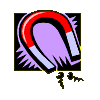![]()

For permanent magnets.
| Atomic Number: | 27 |
| Atomic Symbol: | Co |
| Atomic Weight: | 58.9332 |
| Electron Configuration: | [Ar]4s23d7 |
(Kobald, from the German, goblin or evil spirit, cobalos, Greek, mine) Brandt discovered cobalt in about 1735.
Cobalt occurs in the minerals cobaltite, smaltite, and erythrite, and is often associated with nickel , silver , lead , copper , and iron ores, from which it is most frequently obtained as a by-product. It is also present in meteorites.
Important ore deposits are found in Zaire, Morocco, and Canada. The U.S. Geological Survey has announced that the bottom of the north central Pacific Ocean may have cobalt-rich deposits at relatively shallow depths in water close to the the Hawaiian Islands and other U.S. Pacific territories.
Cobalt is a brittle, hard metal, resembling iron and nickel in appearance. It has a metallic permeability of about two thirds that of iron. Cobalt tends to exist as a mixture of two allotropes over a wide temperature range. The transformation is sluggish and accounts in part for the wide variation in reported data on physical properties of cobalt.
It is alloyed with iron, nickel and other metals to make Alnico, an alloy of unusual magnetic strength with many important uses. Stellite alloys, containing cobalt, chromium , and tungsten , are used for high-speed, heavy-duty, high temperature cutting tools, and for dies.
Cobalt is also used in other magnetic steels and stainless steels, and in alloys used in jet turbines and gas turbine generators. The metal is used in electroplating because of its appearance, hardness, and resistance to oxidation.
The salts have been used for centuries to produce brilliant and permanent blue colors in porcelain, glass, pottery, tiles, and enamels. It is the principal ingredient in Sevre's and Thenard's blue. A solution of the chloride is used as a sympathetic ink. Cobalt carefully used in the form of the chloride, sulfate, acetate, or nitrate has been found effective in correcting a certain mineral deficiency disease in animals.
Soils should contain 0.13 to 0.30 ppm of cobalt for proper animal nutrition.
Cobalt-60, an artificial isotope, is an important gamma ray source, and is extensively used as a tracer and a radiotherapeutic agent.
Single compact sources of Cobalt-60 vary from about $1 to $10/curie, depending on quantity and specific activity.
Exposure to cobalt (metal fumes and dust) should be limited to 0.05 mg/m3 (8-hour time-weighted average 40-hour week).
Sources: CRC Handbook of Chemistry and Physics and the American Chemical Society.
Last Updated: 12/19/97, CST Information Services Team